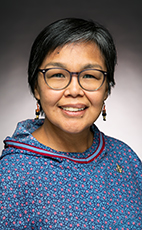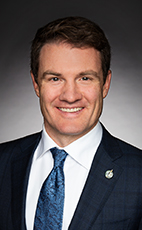44th Parl. 1st Sess.
September 16, 2024 11:00AM
- Sep/16/24 2:12:25 p.m.
- Watch
Mr. Speaker, after nine years of the NDP-Liberal government, taxes are up, costs are up, crime is up and time is up.
The carbon tax has increased the costs of food, fuel and home heating. As a result, we are seeing record numbers of working Canadian families relying on food banks. To make matters worse, the NDP-Liberal government plans to quadruple the carbon tax, and it continues to vote for soft-on-crime policies. Since 2015, violent crime in Winnipeg has gone up by 67%, car thefts have gone up by 63%, homicides have gone up by 100% and gun crime has gone up by a whopping 177%. This is the Liberal-NDP record: Canadians struggling to afford food and crime and chaos in our streets.
Today in Elmwood—Transcona, Winnipeggers have a simple choice. A vote for the NDP is a vote for the Liberals and their soft-on-crime carbon tax agenda. Only a common-sense Conservative government will axe the tax, build the homes, fix the budget and stop the crime.
177 words
- Hear!
- Rabble!
- add
- star_border
- share
- Sep/16/24 7:34:11 p.m.
- Watch
Madam Speaker, the Tina Fontaine story is one I would commend all members to become familiar with. I found it to be inspirational, personally. It is the story of very young girl who went missing. She was murdered and was then found in the river. A lot of the issues surrounding the types of things we are talking about today and on many other days are found in this story, and we can learn from that particular story. The reason I brought up the Bear Clan Patrol is that this is a group of individuals who, over the years, has really moved the ball forward by encouraging law enforcement agencies, not just in Winnipeg but all over the place, quite frankly, to be more sensitive and to better understand the issue of reconciliation, among other things.
136 words
- Hear!
- Rabble!
- add
- star_border
- share
- Sep/16/24 9:33:54 p.m.
- Watch
Mr. Speaker, I will be sharing my time with the member for Winnipeg Centre.
Before I begin, I would like to acknowledge that Canada's Parliament is located on the traditional unceded territory of the Algonquin Anishinabe people.
In less than one month, Canada has become witness to the tragic deaths of no fewer than six people from first nations communities across our country. Although the circumstances in each incident varied as greatly as their age ranges, with the youngest among them just 15 years old and the eldest 57, common to all of them was their involvement in police-related incidents in the final moments of their lives. Tragically, these are not the only examples of these incidents. We do not have to look far in the media, in cities and in towns from coast to coast to coast to find other examples of people from first nations communities who have died in similar incidents. Make no mistake that each is a tragedy and each speaks to deeper and more widespread problems that exist here in Canada.
Indigenous Services Canada and Crown-Indigenous Relations and Northern Affairs Canada are not policing agencies. The mandate and authority related to the administration of the justice system in Canada are not within their purview. These departments, on the other hand, do have an important role to play in building a new relationship with indigenous peoples and in promoting their well-being and safety. This is a priority for these departments and for the Government of Canada.
The primary objective of these departments is supporting indigenous peoples in their efforts toward self-determination and empowering them in shaping the future of their communities. That mandate includes ensuring that indigenous peoples and communities have access to the services they require, including health, education and social services. Our vision is one in which indigenous peoples independently deliver services and address the socio-economic conditions in their communities.
The administration of justice, which includes policing and enforcement, is a topic of discussion at a number of tables across the country, led by Crown-Indigenous Relations and Northern Affairs Canada, that are looking at ways of recognizing rights and self-determination. We support a way forward on a rights-based approach while being mindful that policing is one element of the broader justice system. Given this, there are immediate needs and longer-term goals, as well as opportunities to proactively address some of the gaps identified through reports, recent engagements, consultations and even litigation.
I am happy to hear my colleagues on both sides of the House speak about emergency measures that will save lives in situations similar to those we have been discussing this evening. I hope that such proposals, if they can be feasibly deployed, will make a meaningful difference, a difference of life and death, it is fair to say, in future encounters between people from first nations communities and law enforcement professionals.
I would like to touch upon some of the programs that Indigenous Services Canada has co-developed with the support of leaders from indigenous communities across the country. The first is the pathways to safe indigenous communities initiative. Community services are an important part of supporting community safety and well-being. Indigenous Services Canada helps first nations, Inuit and Métis communities and partners, both on and off reserve, to implement indigenous-designed projects that improve community safety and well-being. I stress that these projects are not designed and led by officials from the Government of Canada. Rather, they are developed by indigenous partners to create a broad spectrum of community support.
The pathways to safe indigenous communities initiative is providing $120 million over five years between 2021 and 2026 to assist first nations, Inuit and Métis communities and partners, both on and off reserve, to implement indigenous-designed projects to improve community safety and well-being. This initiative supports projects that recognize the importance of traditional knowledge and practices that contribute to greater community safety and well-being, recognize holistic models of community safety and well-being and address existing and emerging needs related to the safety and well-being of indigenous women, girls and 2SLGBTQI+ people.
Most of the initiatives we have heard about today are led by Public Safety Canada and administered through the department's first nations and Inuit policing program, or FNIPP. I will, however, say that Indigenous Services Canada and Crown-Indigenous Relations and Northern Affairs Canada play a supportive role in the matter of indigenous policing by giving advice to Public Safety on the engagement with indigenous communities on policing legislation.
The FNIPP was created in 1991 with the aim of enhancing community policing services, supporting culturally responsive policing in first nations and Inuit communities and recognizing input from indigenous communities of policing services received. Indigenous peoples, like all people in Canada, have a right to receive culturally appropriate and respectful police services, and contributing to safer and healthier indigenous communities is a priority for the Government of Canada.
The United Nations Declaration on the Rights of Indigenous Peoples Act Action Plan commits Canada to leveraging the FNIPP and engaging and working with indigenous communities and with provinces and territories on approaches to enhance policing services that are professional, dedicated, and responsive to first nation and Inuit communities. The costs to run the program are shared between the federal government and the province or territory, while provinces and territories have jurisdiction over operational policing requirements and priorities, and the federal government acts as a funding partner. I am pleased to say that the FNIPP has resulted in dedicated, culturally responsive policing services being established in many first nations communities that would not otherwise have a dedicated on-site policing presence.
The federal government is committed to building on the success of this program. Budget 2021 announced up to $540 million over five years beginning in 2021-22 and $126.8 million ongoing to support Indigenous communities that are currently served under the FNIPP and to expand the program into new communities. With this funding, the Government of Canada has been working with first nations and Inuit communities and with provinces and territories to address priority needs.
Work is already under way on several other key related initiatives, such as to co-develop legislation that would recognize first nations police services as essential services, to work with provinces and territories to identify improvements to program governance with a view to delivering funding faster, and to revisit the program management relationship with the RCMP to ensure that officer availability is more readily considered and integrated in program management decisions. In addition, the Government of Canada has committed to supporting improved community police relations by working with first nations communities, provinces and territories to support community safety officer projects and community police discussions.
At the status of women committee, we heard from countless indigenous women and girls during our study on the red dress alert. Most of them do not trust the police, and there is a lot of work that still needs to be done, regardless of what has already been done. There are several communities that are examples to follow, in which the community is quite close and has built a relationship with the police, and where the police have made an effort. However, there are very few examples, and across Canada a lot more work needs to be done.
I mentioned at the outset of these remarks that Indigenous Services Canada and Crown-Indigenous Relations and Northern Affairs Canada are not policing agencies. They are not mandated or authorized to provide the types of community services that are performed by law enforcement officials. What we can do, on the other hand, is to provide supports for those professionals and to remember the first nations communities from coast to coast to coast to ensure that people are safe in their homes and in their neighbourhoods.
The Government of Canada takes the issue of indigenous safety and well-being very seriously. We are committed to walking the shared path of reconciliation with indigenous people and will continue to work in partnership with first nations and Inuit people and organizations, as well as our external partners, to develop effective solutions. Our end goal is to make sure indigenous peoples from coast to coast to coast are safe and adequately housed. It is also about building capacity, developing skills and providing supports on the ground so indigenous communities can reach their full potential.
Meegwetch.
1420 words
- Hear!
- Rabble!
- add
- star_border
- share
- Sep/16/24 10:00:38 p.m.
- Watch
Uqaqtittiji, I always admire my friend and colleague, the member for Winnipeg Centre, for her vision and great advocacy in ensuring that indigenous peoples' human rights are being upheld, something we do not get to see very often, which we all know is part of the reason we are having this emergency debate.
One of the things that I keep wondering about is what accountability looks like for these people, for the families of these souls we have lost. What will accountability look like for the families of the people the member named in her statement?
96 words
- Hear!
- Rabble!
- add
- star_border
- share
- Sep/16/24 11:44:47 p.m.
- Watch
Mr. Speaker, I know the hour is late. It is almost midnight here in Ottawa, but I cannot think of a more important conversation for us to be having as a country than this one right now. I want to start by thanking my colleagues, the member for Nunavut, the member for Winnipeg Centre and the member for Timmins—James Bay, whose interventions tonight have really done justice to a difficult and important topic.
This is an issue that touches many in northern B.C., the region that I am so honoured to represent. Because of the topic of tonight's debate, I want to start, as others have, by expressing my deep condolences to the families of the six indigenous people, five men and one woman, who lost their lives at the hands of police in just 11 days this month. I also want to use my time tonight to give voice to the anger, pain, dismay and frustration felt by the family members of Dale Culver. Dale was a 35-year-old Gitxsan and Wet'suwet'en man who lived in Prince George but had family roots throughout the northwest.
On the evening of July 18, 2017, the police in Prince George received a call from someone about a suspect, a Caucasian male wearing dark clothes, who was looking into parked vehicles. They said that he might have a weapon and that he might have a partner working with him. The police attended the scene and saw Dale Carver, a clearly indigenous man, on a riding his BMX bike. They called at him to stop, and when he did not, they chased after him, grabbed him by his backpack and pulled him off his bike onto the ground. What happened after that can be read in the B.C. Prosecution Service's report, but the details are horrifying given the violence that was inflicted upon this young man. The report talks about the officer kicking and punching him and spraying him in the face with pepper spray. The officer called for reinforcements, and when those reinforcements showed up, they did the same. They punched him in the head. They kicked him many times. They pepper sprayed their gloves and then put them over his mouth.
Twenty-nine minutes after the altercation, Dale was dead. There were bystanders filming the incident on their cellphones. One of the officers demanded that the bystanders delete the videos from their phones and tried to grab one of the phones out of a bystander's hands. Those bystanders did so because they were threatened by this officer, so there was very little evidence when this case went to court. At one point when he was on the ground, I will add, Dale cried out, “I can't breathe. I can't breathe.”
Two of the officers were charged with manslaughter, something very rare, and it did go to court. The first autopsy and pathology report found that blunt trauma to the head was a likely contributing factor in Dale's death, and through a series of events after that, the prosecutors ended up commissioning a second opinion on the pathology report, which came back with a different conclusion. In the end, the charges against the two officers were stayed. The third officer, the one who grabbed at a cellphone and demanded that bystanders delete the videos, was just recently convicted of obstruction of justice.
We have heard a huge outcry from the families, from the Union of British Columbia Indian Chiefs and from the regional chief of the Assembly of First Nations, Terry Teegee, about the process, about the struggle that indigenous people have in obtaining justice and about the shortcomings of the independent oversight bodies that exist. They are calling for change, and their calls for change relate directly to what is being discussed tonight.
Dale's death, of course, is part of a pattern. It is part of a larger picture. It is a picture that this place, the House, has talked about before, has debated before and has held hearings on before. It makes me think of other stories I have heard from northwest B.C. It makes me think of a remote detachment in our region that saw fit to hang a flag with the thin blue line symbol on it in the detachment. This was brought to my attention out of concern for what it represented; it is a symbol that people in the House will know, and as the Calgary Police Commission has described, as having a “contentious history with roots in division, colonialism and racism”.
It makes me think of another story from the same community, where a young constable was posted. Community members found on his Facebook page a photo of him wearing an Afro wig, with a raised fist and the caption “Black and proud”. He is a Caucasian officer. Another post showed him in colonial dress in front of a Union Jack, with the caption “Now, what's to be done with these pesky natives stirring up trouble in the colonies?” It makes me think of my colleague's comment earlier about the importance of better screening in the recruitment and hiring of RCMP officers.
Of course, these stories make me think of a recent audio recording played in a Smithers courtroom. The recording was made after arrests on November 19, 2021. This of course involved land defenders on a road in a remote part of northern B.C. The recording is of several RCMP officers heard laughing about police violence, mocking arrestees and making derogatory comments about symbols worn by two indigenous women to honour and remember murdered and missing indigenous women and girls. They said, “Do they have [effing] face paint on too? They're not orcs?” Orcs, of course, are fictional monsters from The Lord of the Rings. These are peace officers who were recorded saying this about indigenous people.
Perhaps most disturbing was a clip that caught an officer describing an indigenous arrestee as “that big [effing] ogre-looking dude, he's actually...autistic.” Then he goes on to describe one of the officers grabbing this individual by the testicles and twisting. These are the stories that are part of this picture.
I could get into the parliamentary report on systemic racism in policing in Canada. It has been mentioned already this evening. I think everyone in the House is aware that this is a problem. I heard my Conservative colleagues calling it something else, but with the same effect: that these are systemic biases. They are entrenched biases that affect society and the ability of people to obtain the justice they so rightly deserve. We know these systems of discrimination affect not only indigenous people but also others, and we cannot act urgently enough to see the changes that are needed. That is what I want to say.
I will add this final point, which is that the media built up today, the first day back in Parliament, as a day of division, rancour and expected conflict in the House. What I have heard tonight is quite the opposite. I think there is the basis here for something that could be very important, and I call urgently on my colleagues for us to take this opportunity to ensure that the steps are taken. We need to do better. We need to do better by indigenous people and we need to do better by police officers. Systemic biases do not help the police do their jobs better. They do not help women in the police forces do their jobs better.
With that, I will end by again thanking you, Mr. Speaker, for agreeing to this debate and thanking members for their contributions tonight. Let us not let this go without action.
1315 words
- Hear!
- Rabble!
- add
- star_border
- share






